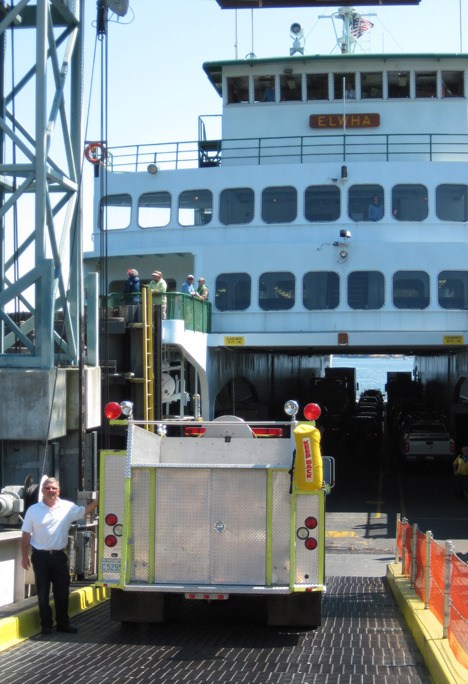It’s time for Orcas to say farewell to the plucky little fire pumper that saved the super ferry Elwha one dark October night in 1983.
“As we get ready to send the still very useful but geriatric pumper to serve in Eastern Washington, it is time to remember her greatest moment,” wrote Chief Mike Harris in a recent press release. He said that when Engine 22 was brand new, it was stationed in Eastsound, the flagship of the fleet.
Sold for one dollar to a fire district in Moses Lake, Orcas Island Fire and Rescue’s recently de-commissioned fire pumper, a 1980 Ford F700, will journey to Eastern Washington to continue its service.
As department reports and newspapers from that time tell the tale, it was the 5 p.m. sailing from Anacortes that went desperately awry between Lopez and Shaw. The Elwha caromed off course in Harney Channel at 17 knots, speeding into Grindstone Harbor, where it struck a rock reef with a great wrenching crash that “everyone within a mile” could hear, as onlooker Norman Kerr told the Seattle Times. The boat jerked upwards with a jolt. The collision tore open the Elwha’s hull, ripping open a 10 foot-long gash about two inches deep and badly mangling the rudder.
Reports of the incident vary wildly: according to the Seattle Times, WSDOT officials said a steering switch failed; Seattle PI and Islands’ Sounder coverage contained allegations that the skipper deliberately brought the ferry into Grindstone Harbor to humor a female passenger who wished to see her house. Ferry riders reported being so close to land, they could look right into the windows of the nearest homes.
By the time the ferry had let passengers off at Shaw and dragged itself into the Orcas dock at 6:15 p.m., it had gulped down 800 to 1,000 gallons of seawater and was sinking lower and lower in the water. The ferry ramp had to be adjusted several times to allow all 60 cars and 100 passengers to disembark.
Firefighters hooked up pumps that began removing water from the hull, but at 7 p.m. the water in the shaft alley bilge was still rising. The crew added yet another pump from Tim’s Mobile Marine service, but water continued pouring into the hull faster than the pumps could remove it. The shaft alley compartment was so befouled by exhaust fumes that most of the crew wore self-contained breathing apparatus.
It was a dire situation until the fire pumper joined in the effort at 7:15 p.m., increasing the drainage rate to 1,200 gallons per minute. Water levels in the bilge finally began to fall.
A couple of hours later, divers Mike Ryan and Doug Hickman drove wooden wedges into the hull crack, slowing the leak by 70%. Soon after, the ferry was able to keep pace using only its own bilge pumps.
The Elwha departed for Seattle at a snail’s pace of 6 knots, loaded with the diving team, pumps and hoses capable of pumping 900 g.p.m., two members of the Coast Guard and three firemen. It arrived safely at the Coleman Dock 11 hours later.
Fire department records indicate that 31 fire department members worked on the scene, helping pump a total of 41,250 gallons of seawater over the side of the Elwha that night.
Without the help of Engine #22, salt-water intrusion into the main drive motor could have cost at least $300,000 more in damages. The Elwha had a chance to say thank you this week as it gave its old friend the fire pumper a lift to Anacortes.
Harris wrote in his press release, “Good luck, Godspeed, and make us proud, ‘Savior’ of the Elwha!”




